Fire Resistance in Screwed and Hollow Core Wooden Elements Filled with Insulating Material
Abstract
:1. Introduction
2. Wall Partition Model
3. Thermal and Transient Analysis
3.1. The Finite Element Method
3.2. The Thermal Material Properties
3.3. The Boundary Conditions
- -
- Radiation and convection on the wall partition side exposed to fire, with the imposed standard fire curve from ISO 834 [11];
- -
- Radiation and convection on the cavity, with the temperature evolution through the curves FG_HOL_ST, FG_HOL_TS, and FG_HOL;
- -
- Convection on the side not exposed to fire;
- -
- Adiabatic or no applied conditions on the lateral edges;
- -
- An ambient temperature of 20 °C considered as the initial condition.
4. Results and Discussion of the Wall Partition Model
4.1. The Fire Resistance
4.2. Fire Resistance in the Models
- A
- The comparison of results between the models with and without fiberglass showed the following:
- -
- In the models without fiberglass, the temperatures inside the cavity were not uniform, as represented through the wooden walls inside. In these models, the temperature inside the cavity was higher at the top and lower at the bottom.
- -
- The models with fiberglass achieved lower temperatures inside their cavities, maintaining more uniform heating both at the top and bottom. This was due to the temperature evolution curve, presented in Figure 5, which shows the properties of the fiberglass until a temperature of 537 °C is reached. In models with fiberglass, heating inside the cavity increased until the temperature of the material reached 619.8 °C (model FG_HOL), which affected fire resistance in terms of decreasing its duration.
- B
- The comparison of results between the models with and without steel screws showed the following:
- -
- The models without screws maintained a constant temperature throughout the thickness of the wooden elements;
- -
- The models with steel screws transmitted greater heat around them, thus affecting the wooden elements;
- -
- The temperature in steel screws near the top increased due to the gypsum being exposed to fire, while screws on the bottom side were of lower temperatures;
- -
- There were no differences in the results between the use of screws with or without threading.
- C
- A comparison of the time fire resistance between all the models showed the following:
- -
- The fire resistance duration of the models with fiberglass decreased by 45 min as the mean, compared with that of models without insulation inside the cavities;
- -
- The duration of fire resistance also decreased by 71.75 min as the mean when steel screws were considered in the numerical simulation.
- -
- The comparison between the use of screws, with and without threads, showed a duration of only 3.5 min of fire resistance.
5. Conclusions
- -
- For the duration of fire resistance, in the numerical models filled with fiberglass, the heating inside the cavity increased until the material reached a temperature of 619.8 °C (model FG_HOL). These models had lesser fire resistance when compared to models without fiberglass inside their cavities, with a mean duration of less than 45 min. This value is noticeable due to the heat produced by the insulated material inside the cavity in permanent contact with the wood element until its degradation. The wall partition filled with fiberglass reached a duration of 223 min of fire resistance.
- -
- The models without fiberglass showed greater heating near the top of the model but greater resistance to heating in the lower part. The gypsum material transmitted heat into the cavities, which promoted a temperature increase through the wood elements, from the top side bordering the fire to the unexposed bottom side. Due to wood’s lower conductivity, the increased temperature on the unexposed side was lower and allowed for higher fire resistance. The wall partition without insulation material inside the cavity reached a duration of 269 min of fire resistance.
- -
- The steel screws in the previous models allowed them to concentrate greater heat and thus distribute greater heat around them to the wooden elements. The use of steel screws decreased the duration of fire resistance by 71.75 min as the mean, independent of the use of a wall partition with or without filled insulation material.
Author Contributions
Funding
Institutional Review Board Statement
Informed Consent Statement
Data Availability Statement
Conflicts of Interest
References
- Winchester, N.; Reilly, J.M. The economic and emissions benefits of engineered wood products in a low-carbon future. Energy Econ. 2020, 85, 104596. [Google Scholar] [CrossRef]
- Balasbaneh, A.T.; Sher, W. Comparative sustainability evaluation of two engineered wood-based construction materials: Life cycle analysis of CLT versus GLT. Build. Environ. 2021, 204, 108112. [Google Scholar] [CrossRef]
- Hildebrandt, J.; Hagemann, N.; Thrän, D. The contribution of wood-based construction materials for leveraging a low carbon building sector in Europe. Sustain. Cities Soc. 2017, 34, 405–418. [Google Scholar] [CrossRef]
- Yang, T.-H.; Wang, S.-Y.; Tsai, M.-J.; Lin, C.-Y. The charring depth and charring rate of glued laminated timber after a standard fire exposure test. Build. Environ. 2009, 44, 231–236. [Google Scholar] [CrossRef]
- Žajdlík, T.; Šuhajda, K.; Průša, D. Medium-Scale Fire Resistance Testing of Timber Structures with Composite Cement Fibre Materials. Buildings 2023, 13, 527. [Google Scholar] [CrossRef]
- Pereira, D.; Fonseca, E.M.M.; Osório, M. Temperature Evolution inside Hollow Core Wood Elements and Fire Resistance. Fire 2024, 7, 57. [Google Scholar] [CrossRef]
- Pereira, D.; Fonseca, E.M.M.; Osório, M. Computational Analysis for the Evaluation of Fire Resistance in Constructive Wooden Elements with Protection. Appl. Sci. 2024, 14, 1477. [Google Scholar] [CrossRef]
- CEN. EN 1363-1; Fire Resistance Tests Part 1: General Requirements. CEN: Brussels, Belgium, 2020.
- CEN. EN 1364-1; Fire Resistance Tests for Non-Loadbearing Elements. Part 1: Walls. CEN: Brussels, Belgium, 2015.
- CEN. EN1991-1-2; Eurocode 1: Actions on Structures. Part 1–2: Structural Fire Design. BSI: Brussels, Belgium, 2010.
- ISO 834-1; Fire Resistance Tests-Elements of Building Construction—Part 1: General Requirement. International Organization for Standardization: Geneva, Switzerland, 1999. Available online: https://www.iso.org/standard/2576.html (accessed on 20 November 2023).
- CEN. EN1995-1-2; Eurocode 5: Design of Timber Structures. Part 1–2: General Structural Fire Design. BSI: Brussels, Belgium, 2004.
- Kumar, D.; Alam, M.; Zou, P.X.; Sanjayan, J.G.; Memon, R.A. Comparative analysis of building insulation material properties and performance. Renew. Sustain. Energy Rev. 2020, 131, 110038. [Google Scholar] [CrossRef]
- Papadopoulos, A.M. State of the art in thermal insulation materials and aims for future developments. Energy Build. 2005, 37, 77–86. [Google Scholar] [CrossRef]
- Cao, X.; Liu, J.; Cao, X.; Li, Q.; Hu, E.; Fan, F. Study of the thermal insulation properties of the glass fiber board used for interior building envelope. Energy Build. 2015, 107, 49–58. [Google Scholar] [CrossRef]
- Xu, Q.; Wang, Y.; Chen, L.; Gao, R.; Li, X. Comparative experimental study of fire-resistance ratings of timber assemblies with different fire protection measures. Adv. Struct. Eng. 2016, 19, 500–512. [Google Scholar] [CrossRef]
- Abu-Jdayil, B.; Mourad, A.H.; Hittini, W.; Hassan, M.; Hameedi, S. Traditional, state-of-the-art and renewable thermal building insulation materials: An overview. Constr. Build Mater. 2019, 214, 709–735. [Google Scholar] [CrossRef]
- Takeda, H.; Mehaffey, J.R. WALL2D: A Model for Predicting Heat Transfer through Wood-Stud Walls Exposed to Fire. Fire Mater. 1998, 22, 133–140. [Google Scholar] [CrossRef]
- ANSYS, Inc. ANSYS Mechanical APD 2022 R2; Release 2; ANSYS, Inc.: Southpointe, PA, USA, 2022. [Google Scholar]
- Frangi, A.; Schleifer, V.; Fontana, M.; Hugi, E. Experimental and Numerical Analysis of Gypsum Plasterboards in Fire. Fire Technol. 2010, 46, 149–167. [Google Scholar] [CrossRef]
- C04 Partitions, Non-Loadbearing Timber Stud. Traditional Stud Partitions. White Book S11, 275–286, Ireland. Available online: https://www.gyproc.ie/en/assets/download/media/1306 (accessed on 4 March 2024).
- Pang, S.J.; Ahn, K.S.; Oh, J.W.; Lee, H.S.; Kang, S.G.; Oh, J.K. Fire Resistance of Structural Wooden Walls Covered by Gypsum and Diatomite Board. BioResouces 2023, 18, 991–1007. [Google Scholar] [CrossRef]
- CEN, EN1993-1-2; Eurocode 3: Structural Fire Design. Part 1–2: General Rules. BSI: Brussels, Belgium, 2005.
- San Diego Seal, Inc. Fiberglass Fabric Cloth, High Temperature, Heat & Flame Resistant Thermal Insulating; SDSI Industrial & Marine Sealing Devices: San Diego, CA, USA, 2024; Available online: http://sandiegoseal.com/pdf/fibercloth.pdf (accessed on 4 March 2024).
- Létourneau-Gagnon, M.; Dagenais, C.; Blanchet, P. Fire Performance of Self-Tapping Screws in Tall Mass-Timber Buildings. Appl. Sci. 2021, 11, 3579. [Google Scholar] [CrossRef]
- Wang, Y.; Li, X.; Liu, P.; Wu, C.; Liu, C.; Zeng, L.; He, W.; Yin, T. Mechanical Behavior of High-Strength Bolted Joints Fabricated from Fire-Resistant Steel at Elevated Temperatures. Adv. Mater. Sci. Eng. 2022, 2022, 8265019. [Google Scholar] [CrossRef]
- Król, P.A.; Wachowski, M. Effect of Fire Temperature and Exposure Time on High-Strength Steel Bolts Microstructure and Residual Mechanical Properties. Materials 2021, 14, 3116. [Google Scholar] [CrossRef] [PubMed]


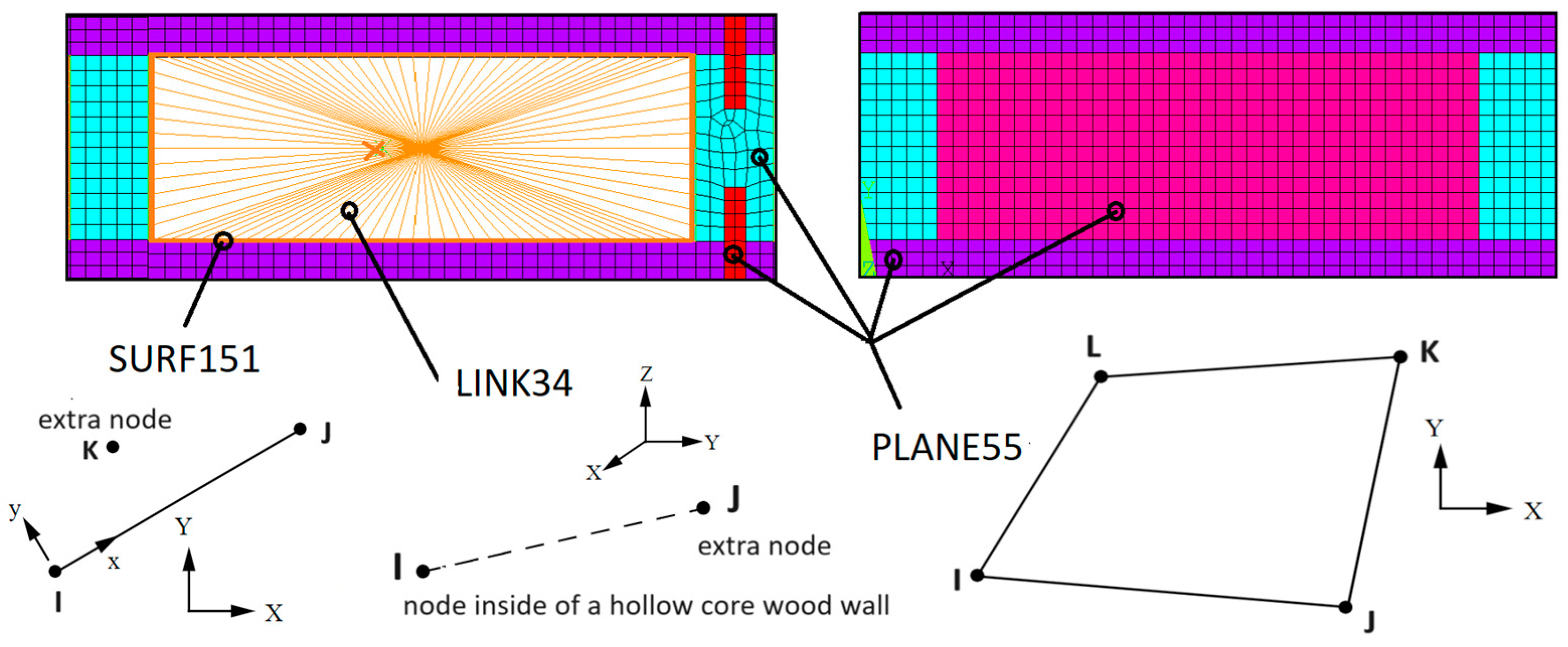
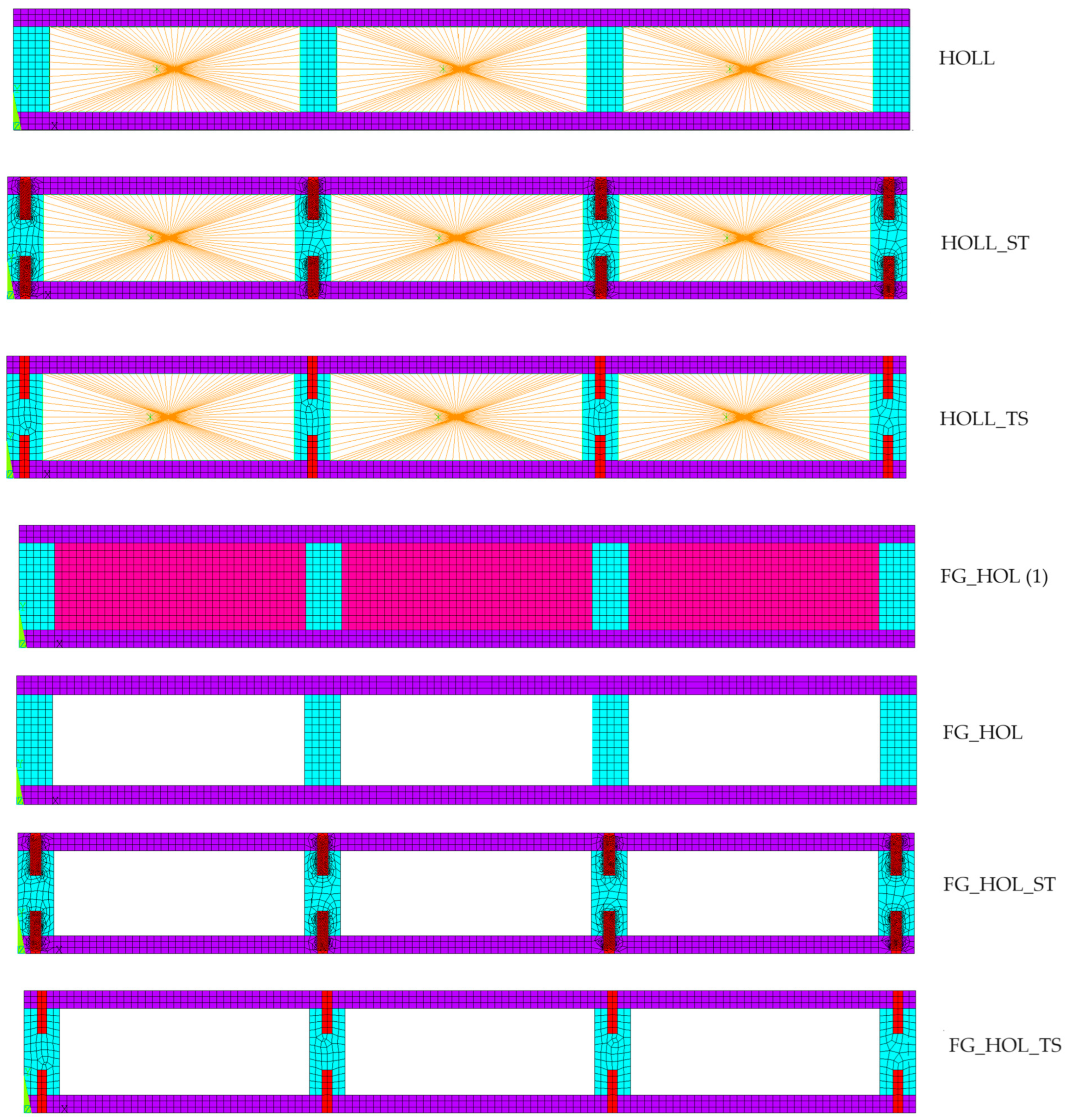
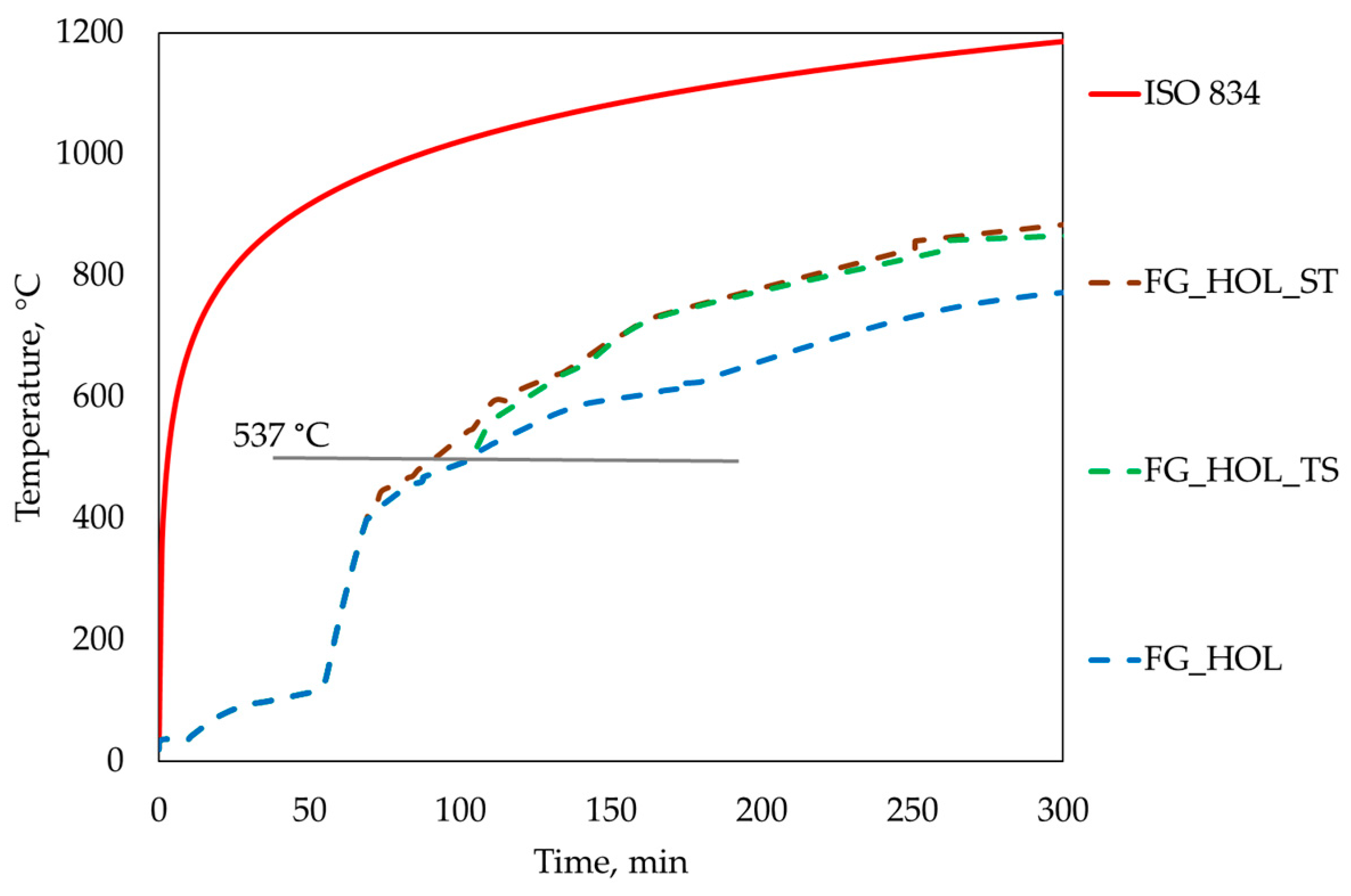

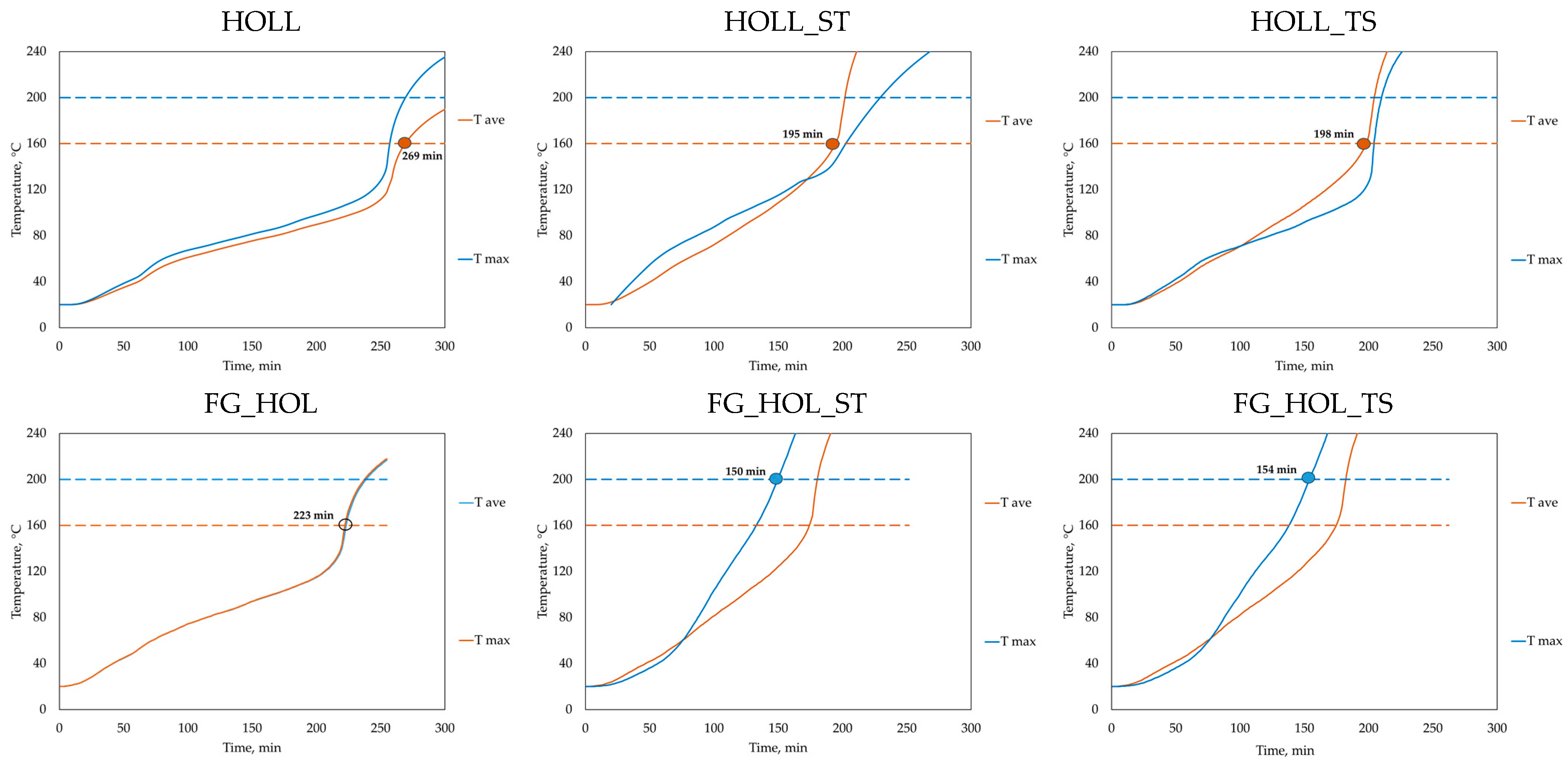
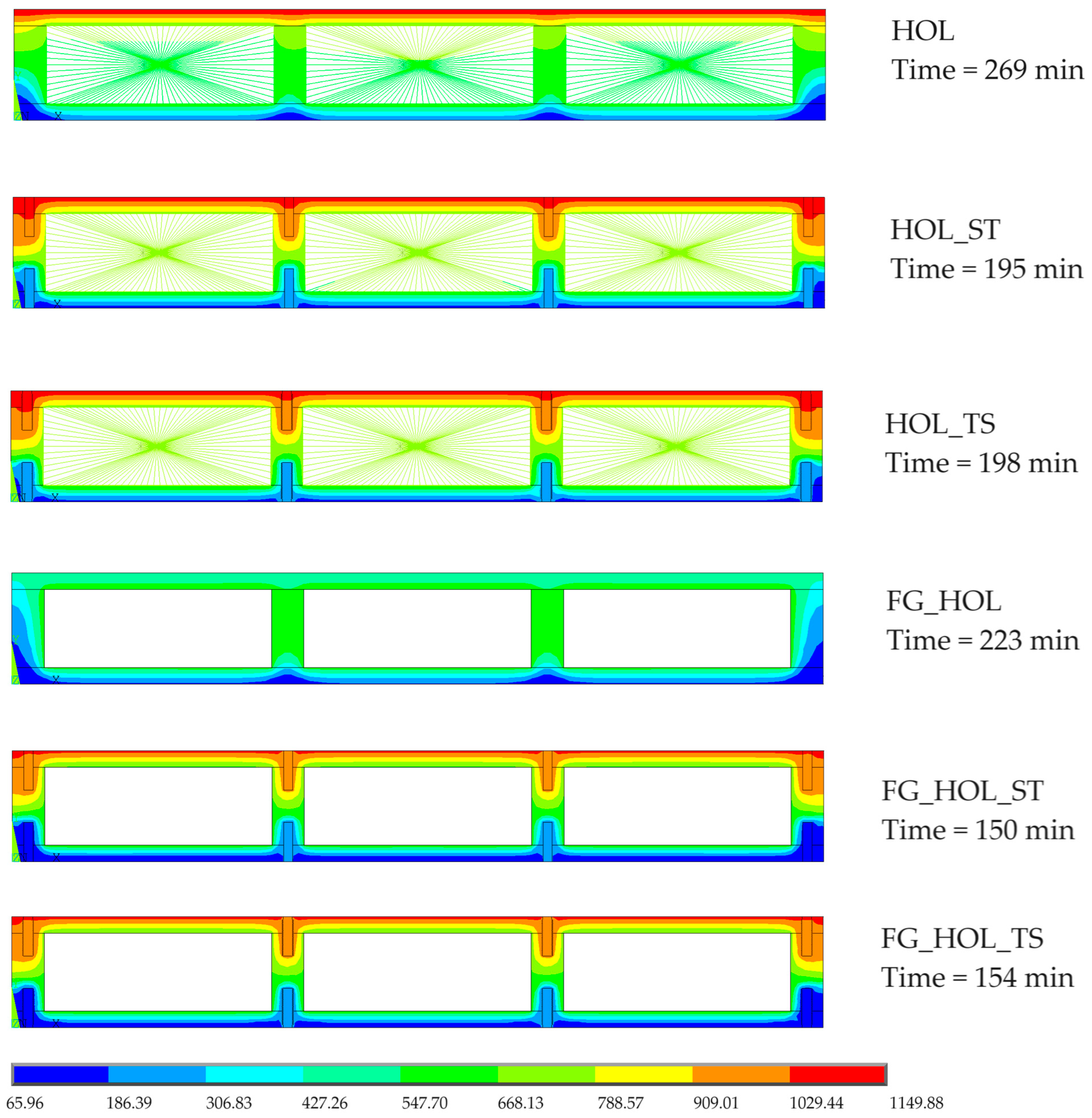
| Wall Partition Model Type: | Designation | Materials |
|---|---|---|
| Hollow cavities | HOLL | Wood and gypsum |
| Hollow cavities screwed with thread | HOLL_ST | Wood, gypsum, and steel screw thread |
| Hollow cavities screwed without thread | HOLL_TS | Wood, gypsum, and steel screw threadless |
| Filled hollow cavities with insulation | FG_HOL | Wood, gypsum, and fiberglass |
| Hollow cavities insulated and screwed with thread | FG_HOL_ST | Wood, gypsum, fiberglass, and steel screw thread |
| Hollow cavities insulated and screwed without thread | FG_HOL_TS | Wood, gypsum, fiberglass, and steel screw threadless |
| Temperature, °C | Density, kg/m3 | Temperature, °C | Specific Heat, kJ/kgK | Temperature, °C | Thermal Conductivity, W/mK |
|---|---|---|---|---|---|
| 20 | 7850 | 20 | 0.440 | 20 | 53.334 |
| 50 | 0.460 | 799–1200 | 27.393 | ||
| 100 | 0.488 | ||||
| 150 | 0.510 | ||||
| 200 | 0.530 | ||||
| 250 | 0.547 | ||||
| 300 | 0.565 | ||||
| 350 | 0.584 | ||||
| 400 | 0.606 | ||||
| 450 | 0.633 | ||||
| 500 | 0.667 | ||||
| 550 | 0.708 | ||||
| 600 | 0.760 | ||||
| 650 | 0.814 | ||||
| 700 | 1.008 | ||||
| 730 | 2.291 | ||||
| 735 | 5.000 | ||||
| 750 | 1.483 | ||||
| 785 | 0.875 | ||||
| 800 | 0.803 | ||||
| 825 | 0.735 | ||||
| 850 | 0.695 | ||||
| 890 | 0.657 | ||||
| 1200 | 0.650 |
| Temperature, °C | Density, kg/m3 | Temperature, °C | Specific Heat, kJ/kgK | Temperature, °C | Thermal Conductivity, W/mK |
|---|---|---|---|---|---|
| 20 | (1 + 0.12) * 537.6 | 20 | 1.53 | 20 | 0.12 |
| 99 | (1 + 0.12) * 537.6 | 99 | 1.77 | 200 | 0.15 |
| 120 | (1.0) * 480.0 | 100 | 13.60 | 350 | 0.07 |
| 200 | (1.0) * 480.0 | 120 | 13.50 | 500 | 0.09 |
| 250 | (0.93) * 446.4 | 121 | 2.12 | 800 | 0.35 |
| 300 | (0.76) * 364.8 | 200 | 2.00 | 1200 | 1.50 |
| 350 | (0.52) * 249.6 | 250 | 1.62 | ||
| 400 | (0.38) * 182.4 | 300 | 0.71 | ||
| 600 | (0.28) * 134.4 | 350 | 0.85 | ||
| 800 | (0.26) * 124.8 | 400 | 1.00 | ||
| 1200 | (0) * 0.0 | 600 | 1.40 | ||
| 800 | 1.65 | ||||
| 1200 | 1.65 | ||||
| Temperature, °C | Density, kg/m3 | Temperature, °C | Specific Heat, kJ/kgK | Temperature, °C | Thermal Conductivity, W/mK |
|---|---|---|---|---|---|
| 20 | 15.00 | 20 | 0.84 | 20 | 0.045 |
| Temperature, °C | Density, kg/m3 | Temperature, °C | Specific Heat, kJ/kgK | Temperature, °C | Thermal Conductivity, W/mK |
|---|---|---|---|---|---|
| 20 | 889.00 | 20 | 0.95 | 20 | 0.190 |
| 100 | 889.00 | 100 | 0.95 | 195 | 0.190 |
| 170 | 737.87 | 135 | 25.00 | 155 | 0.100 |
| 600 | 737.87 | 170 | 0.95 | 200 | 0.103 |
| 750 | 700.98 | 650 | 0.95 | 400 | 0.113 |
| 1200 | 700.98 | 675 | 10.00 | 600 | 0.127 |
| 700 | 0.95 | 800 | 0.145 | ||
| 1200 | 0.95 | 1200 | 0.165 |
Disclaimer/Publisher’s Note: The statements, opinions and data contained in all publications are solely those of the individual author(s) and contributor(s) and not of MDPI and/or the editor(s). MDPI and/or the editor(s) disclaim responsibility for any injury to people or property resulting from any ideas, methods, instructions or products referred to in the content. |
© 2024 by the authors. Licensee MDPI, Basel, Switzerland. This article is an open access article distributed under the terms and conditions of the Creative Commons Attribution (CC BY) license (https://creativecommons.org/licenses/by/4.0/).
Share and Cite
Osório, M.; Fonseca, E.M.M.; Pereira, D. Fire Resistance in Screwed and Hollow Core Wooden Elements Filled with Insulating Material. Fire 2024, 7, 288. https://doi.org/10.3390/fire7080288
Osório M, Fonseca EMM, Pereira D. Fire Resistance in Screwed and Hollow Core Wooden Elements Filled with Insulating Material. Fire. 2024; 7(8):288. https://doi.org/10.3390/fire7080288
Chicago/Turabian StyleOsório, Miguel, Elza M. M. Fonseca, and Domingos Pereira. 2024. "Fire Resistance in Screwed and Hollow Core Wooden Elements Filled with Insulating Material" Fire 7, no. 8: 288. https://doi.org/10.3390/fire7080288







